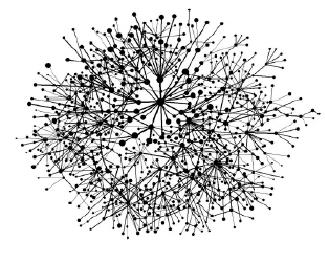Avi Blizovsky

Internet news site surfers access to read articles only in the first 36 hours after they first go live. This is the conclusion that emerges from a statistical analysis study, conducted by physicists who study social networks, and analyzed the way in which people access online information. Albert Lazio Barabashi, University of Notre Dame in the USA, and his colleagues from his native country, Hungary, calculated that the number of people surfing, who read a news "item", drops the longer the story is on the Internet, almost all at once, rather than in a rapid gradual decline, as is customary to think. Most news stories expire within a day - to a day and a half, from the moment they are uploaded to websites, a finding that may help website designers or people trying to understand how information is transmitted in biological cells and social networks.
Physicists, such as Barbarashi, are interested in studying the World Wide Web because it is a good example of "complex networks", with a changing topology, as new documents and links continue to be added to them. Barbarashi's team described a typical news site as a series of nodes, each associated with one news story, and lines connecting the stories, if the physical articles are linked together. The area of each such node, which looks like a bubble, is proportional to the logarithm of the number of visitors to each of the documents. Their model reveals that a typical news site has a stable "skeleton", to which stories are linked with temporary links before they are deleted from the site, or before the link to them is deleted. In this logic, the network is similar to the control network of living cells, whose "wiring" can change rapidly during the cell's life cycle. This network is also similar to social networks: everyone has a stable network of friends and acquaintances, but the number of people you are in contact with varies from day to day.
Barbarashi and his colleagues studied the reading pattern of "items" on a popular news and entertainment website in Hungary. With the help of the "cookies" they planted, the scientists were able to reproduce the surfing pattern of 250 thousand surfers on the site, for a month. The researchers found that the documents belonging to the skeleton of the site received a uniform flow of surfers, which means that the number of surfers increased linearly over time. Contrary to this, the "News News" received the greatest number of exposures immediately after their introduction, and the introductions to them waned and went away with the passage of time.
Barashi's staff members calculated the half-life of a "news item" (the term borrowed from physics, the time it takes for unstable atoms to break up and turn into stable atoms, such as uranium to lead), meaning the time it was viewed by half of the total visitors to the page. They found that "news items" have a short lifespan, although some of them receive entries beyond this period. The half-life of a news item is a total of 36 hours.
The short life time of a news item, at the same time as a random browsing pattern, means that people may miss a considerable proportion of the news, if they do not visit the site when the news is displayed for the first time, this is why website owners offer surfers news alerts by email. In addition, the result shows that people read news, not only because of the matter they find in them, but also because of the convenient accessibility to them.
The rapid decay of the reading of the new items is not content-dependent, but is determined, mainly, by the patterns of visiting websites and the user's surfing. According to the researchers, understanding the quantitative approach to online media not only offers a better understanding of access to information, but can be useful in planning commercial applications - from better planning of the portal to understanding the way information circulates, flows and is marketed in the online world." The researchers conclude.
The science site works differently from a regular news site, because it, like a secret, does not lose a drop. Many surfers reach the deep archive - 7,000 articles and articles, both directly from Google, and by navigating through the various experts, each of whom is dedicated to a unique topic, or through the search engine.
For news on Physix Web from which the research results are received
Drafting and editing: H. J. Glykasm, translations and technical writing

One response
There is no doubt that this is the dynamic.
In practice it is even more extreme - that is, after three hours of the publication of the article, there is already a significant drop in the number of views. On sites like Ynet - after an article no longer appears on the main page - the number of views on the article drops drastically. You can see this by the way in the amount of comments that are written to each article in the first three hours of its publication. There is a relatively low percentage of people who actually enter each category to read more articles. And even if it happens, it is usually reduced to a specific field of interest such as culture or computers...